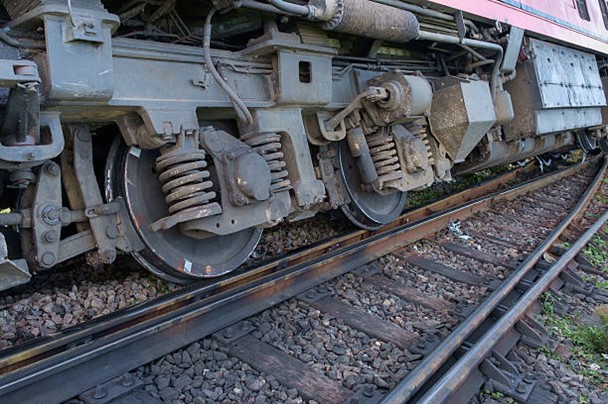
Train derailments can be catastrophic, causing severe injuries, loss of life, and extensive property damage. While train travel is generally safe, derailments still occur due to a variety of factors, from mechanical failures to human error. Understanding the most common causes of train derailments can help prevent future accidents and ensure accountability when negligence plays a role.
What Causes Train Derailments?
A train derailment happens when a train comes off its tracks, often leading to crashes, fires, and hazardous material spills. The Federal Railroad Administration (FRA) reports that derailments are responsible for millions of dollars in damages each year.
The Top Causes of Train Derailments
- Track Defects – One of the leading causes of derailments, broken rails, misaligned tracks, and switch failures can cause trains to jump off their tracks. Poor maintenance increases these risks.
- Mechanical Failures – Malfunctioning brakes, wheel defects, or issues with the locomotive engine can contribute to derailments. Routine inspections are critical to preventing mechanical breakdowns.
- Human Error – Train operators must follow strict speed limits, braking procedures, and track-switching protocols. Mistakes in operation or miscommunication between conductors and rail controllers can lead to derailments.
- Speeding – Excessive speed, especially around curves or in areas with poor track conditions, increases the likelihood of derailments. Many past derailments have been linked to trains traveling above recommended speeds.
- Obstructions on the Tracks – Fallen trees, vehicles at crossings, debris, and even animals on the tracks can force a train off its rails. Railroad companies must ensure tracks are clear and visible.
- Defective Train Components – Faulty couplings, axles, or wheel bearings can cause trains to separate or become unstable, leading to derailments. Manufacturing defects can also play a role.
- Poor Weather Conditions – Heavy rain, flooding, snow, and ice can weaken tracks, cause landslides, or reduce a train’s ability to brake effectively.
- Hazardous Cargo & Overloading – Trains carrying hazardous materials must follow strict safety regulations. Overloading or improperly securing cargo can shift weight distribution and throw a train off balance.
- Negligent Maintenance – Railroad companies are responsible for ensuring that tracks, signals, and train components are regularly inspected and maintained. Failure to do so can lead to preventable derailments.
- Bridge or Tunnel Failures – Structural weaknesses in bridges or tunnels can lead to catastrophic derailments, especially if inspections are not conducted regularly.
Who Is Liable in a Train Derailment?
Depending on the cause of the derailment, liability may fall on:
- Railroad companies for failing to maintain tracks and trains properly.
- Train operators for reckless or negligent driving.
- Manufacturers for producing defective train parts.
- Government agencies for inadequate track inspections and safety regulations.
What to Do If You’re Injured in a Train Derailment
- Seek medical attention immediately.
- Document the accident – Take photos and videos if possible.
- Gather witness information – Statements can be crucial for legal claims.
- Consult a train accident attorney – An experienced lawyer can help determine liability and pursue compensation for your injuries.
How Buckeye Law Group Can Help
Our legal team investigates train derailments, works with accident reconstruction experts, and fights for victims’ rights. If you or a loved one has been injured in a train accident, we are here to help.
Call 800-411-PAIN or complete our contact form for a free, no-obligation case consultation today.
How Railroad Crossing Negligence Leads to Fatal Accidents
Railroad crossings are some of the most dangerous intersections on the road. When safety precautions fail due to negligence, tragic accidents can occur, often resulting in catastrophic injuries or fatalities.
Shoulder Dystocia: Birth Injury Risks and Legal Options
Shoulder dystocia is a serious birth complication that occurs when a baby’s shoulder becomes trapped behind the mother’s pelvic bone during delivery. This emergency situation can lead to nerve damage,
Medication Errors: Understanding the Risks and Legal Options
Medication errors are a serious issue in healthcare, causing thousands of injuries and deaths each year. Whether it’s a doctor prescribing the wrong drug, a pharmacist mislabeling a bottle, or
How Red Light Cameras Help Prevent Intersection Crashes
Intersections are some of the most dangerous areas on the road. Every year, thousands of accidents are caused by drivers who run red lights—often leading to serious injuries or fatalities.
Legal Rights of Pedestrians Hit by Negligent Drivers
Pedestrians have the right to walk safely without fear of being hit by negligent drivers. Unfortunately, careless, distracted, or reckless drivers often put pedestrians at risk. When a pedestrian is
Lung Cancer Misdiagnosis: When Medical Negligence Puts Lives at Risk
A lung cancer diagnosis can be life-changing, but what happens when doctors fail to detect the disease or mistake it for something else? Lung cancer misdiagnosis is a serious form
Laboratory Errors: How Mistakes in the Lab Can Lead to Serious Medical Harm
Laboratory tests play a critical role in diagnosing illnesses, guiding treatment plans, and monitoring patient progress. Unfortunately, when laboratory errors occur, the consequences can be severe—leading to misdiagnosis, delayed treatment,
How to Hold a Drunk Driver Accountable After an Accident
Drunk driving remains one of the most dangerous and reckless behaviors on the road, causing thousands of fatal and life-altering accidents each year. If you or a loved one has
Common Injuries Cyclists Face in Traffic Accidents
Cyclists face significant risks when sharing the road with motor vehicles. Unlike drivers, they lack the protection of a metal frame, airbags, or seat belts, making them highly vulnerable in
Heart Disease Misdiagnosis: The Consequences of Medical Negligence
Heart disease is the leading cause of death in the United States, making early detection crucial for survival. However, misdiagnosis or delayed diagnosis of heart disease can lead to severe
